Palm Phone Review
Palm Phone Review
A curious solution to a very modern problem
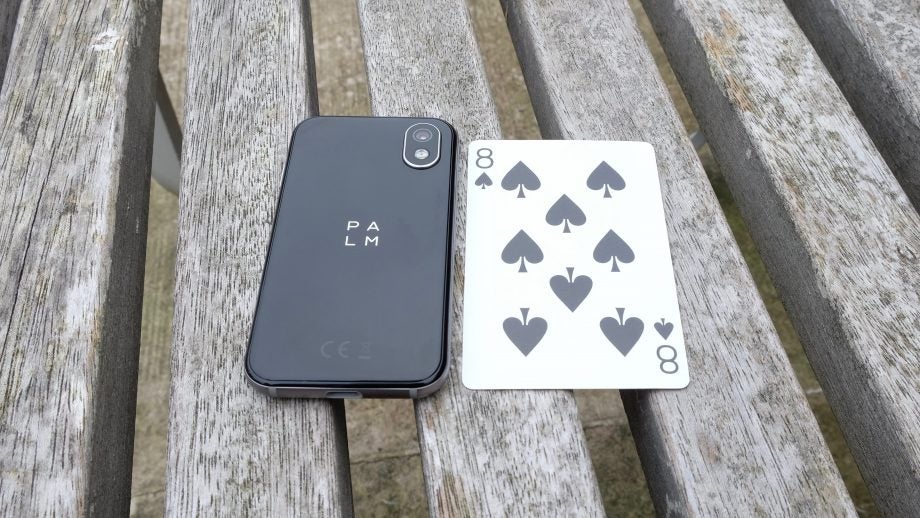
Verdict
The Palm Phone is a noble failure. It’s a device that bravely explores a new path to recovering some of the lost time and attention that successive smartphones have stolen from us. Ultimately, though, it ends up stranded in a no-man’s land of tiny text and insufficient stamina.
Pros
- Cute design
- Most portable smartphone ever
- Streamlined UI
Cons
- Truly abysmal battery life
- Accurate typing almost impossible
- Camera not up to scratch
Key Specifications
- Review Price: £350
- 3.3-inch IPS LCD, 1280 x 720
- 12MP main camera
- 8MP front camera
- Snapdragon 435 CPU
- 3GB RAM/32GB storage
- 800mAh battery
- Android 8.1 Oreo
What is the Palm Phone?
The Palm Phone is a curious solution to a very modern problem. It attempts to answer the call to minimise the time we spend with our smartphones by giving us an additional gadget to lug around.
If you think that sounds like it might unnecessarily complicate matters rather than simplify them, then you’d be right. But there’s one key thing you need to understand about the Palm Phone: it’s really, really small.
For a price of £350 up-front, or from £31 per month on contract with Vodafone (not inconsiderable for what is supposed to be a secondary device), the idea is to provide the functionality of a smartphone with the convenience of a smartwatch. That’s almost word for word the line provided by Vodafone, which is the exclusive Palm Phone provider here in the UK for the first half of 2019.
In addition, this tiny handset offers a much-simplified take on Android. This is intended to give you a basic calling and messaging experience for those occasions where anything more would be an unwanted distraction.
Related: Best smartphones 2019
Palm Phone – Design
So yes, the Palm Phone’s defining attribute is that it is small. We’re not talking small in the modern smartphone context, where anything with a sub-5.5-inch display is considered petite. But super-skinny jeans pocket, lost down the back of the sofa small.
The blurb claims that it’s “as small as your credit card,” which is true to a certain extent. At 96.5 x 50.5mm, it is indeed conceivable that you could momentarily lose it behind a store card or train ticket.
Held side on, however, it’s just as thick as any regular smartphone. In fact, at 10mm it’s a little thicker than you might be used to.
Not that this poses any portability problems. The Palm Phone’s rounded, distinctly iPhone-esque shape and weight of just 62.5g ensure that it slips easily into and out of even the tiniest pockets.
Related: Sony Xperia XZ4
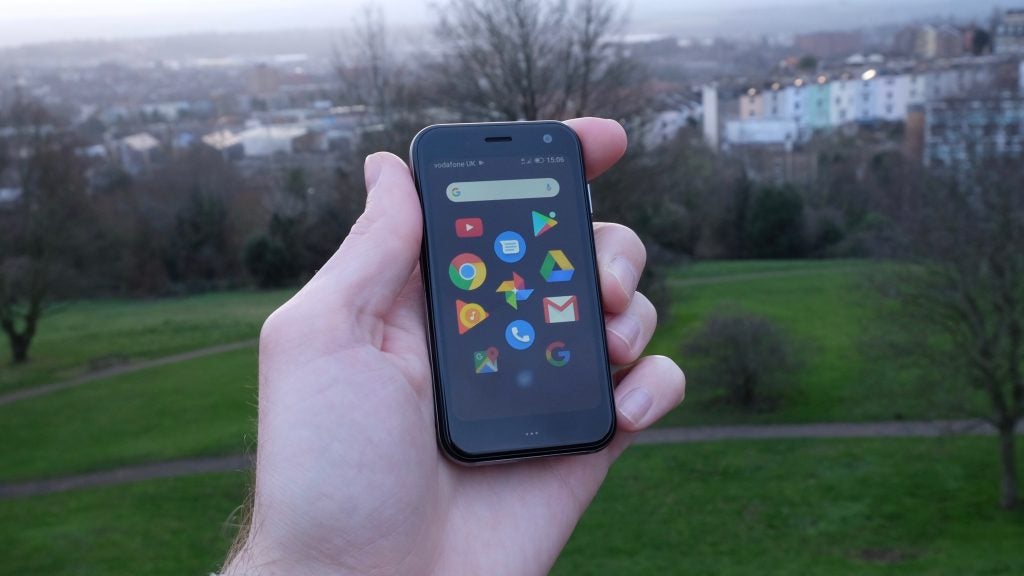
One of the reasons the phone can be so light, aside from its compact dimensions, is that its body is formed of plastic rather than aluminium. Its glass front and back means it doesn’t feel cheap exactly. But the fake metal-effect rim definitely calls to mind one of the many generic sub-£200 phones we’ve tested over the years.
More consequential than the Palm Phone’s lack of a 3.5mm jack (USB-C being the sole external port) is the complete omission of a physical volume control. There’s a power button on the right hand edge, and that’s it.
If you want to adjust the phone’s volume, you’ll have to pull down the notification menu within the OS. This proves to be a bit of a pain, especially if you’re listening to music on the device and your headphones don’t have an independent volume control on them.
On the plus side, the Palm Phone does sport an IP68 dust- and water-resistant rating. Given that this is supposed to be the kind of phone you’ll take out with you when you’re doing something active, it’s a smart inclusion.
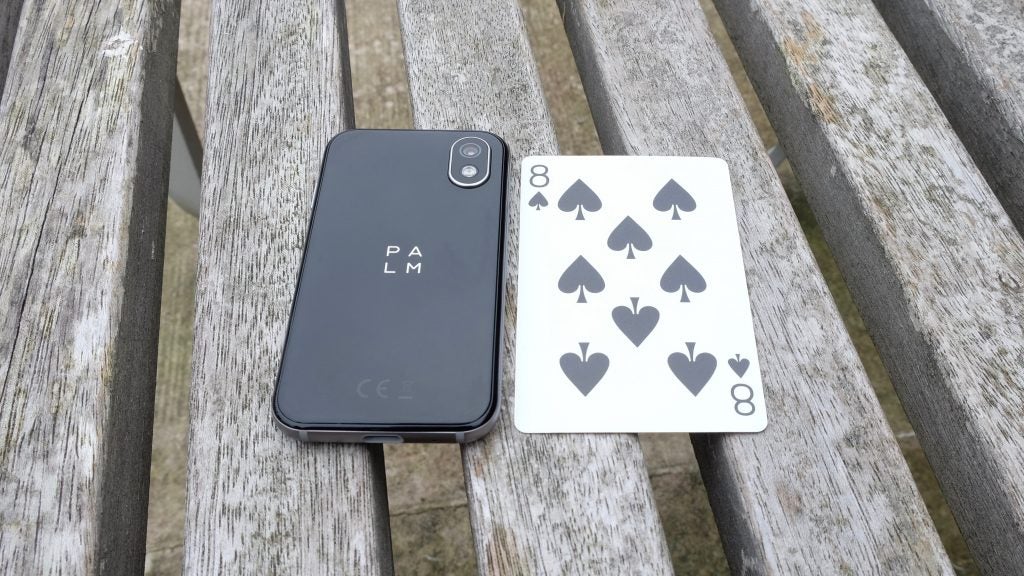
This is also a case where the provision of a facial-unlock system is genuinely useful. It might not be as secure as the best examples of this technology, but without fingerprint authentication – for obvious space-saving reasons – it is most welcome.
Palm Phone – Display
The Palm Phone’s diminutive dimensions obviously have a major effect on the number of components, not least its display. At 3.3 inches, this is comfortably the smallest smartphone screen out there.
Even the very first iPhone, way back in 2007, packed in a 3.5-inch screen – which is positively roomy by comparison.
This much-reduced display area has a uniquely polarising effect on everyday apps such as Gmail and Chrome. Let’s use Gmail as the example here. On the positive side, you get the return of genuine one-handed usage, so you can navigate and compose emails with the thumb of the hand holding the phone. There’s no uncomfortable stretching or double-jointed digit gymnastics required.
Related: Sony Xperia XZ4
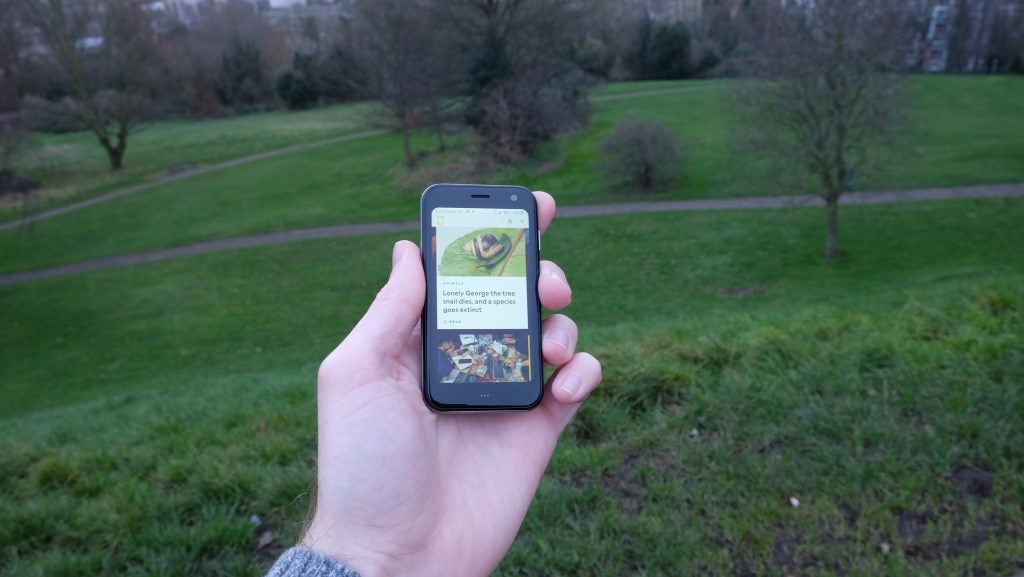
Conversely, you’ll need to bring the phone right up to your face to read the text, and you’ll find that virtually every word you type will contain several typos. The keyboard’s word correction feature is put to work on the Palm Phone like no other device before it.
The screen is simply too small to do normal smartphone stuff on it. Browsing the internet on the Palm Phone borders on the ridiculous, with even the mobile-focused websites of today rendered with eye-strainingly tiddly text and images that apply a whole new meaning to the term “thumbnail”.
That’s not to say that this is a bad display as such. Quite the opposite. It’s bright and accurate, with an ostensibly modest 1280 x 720 resolution that actually produces a pixel-packed 445ppi in such a constrained form factor.
Ultimately, though, if there’s a minimum acceptable screen size for modern smartphone applications, then the Palm Phone falls well below it.
Palm Phone – Performance
Picking up a Palm Phone and expecting cutting-edge performance would be to miss the point entirely. This is a phone that exists to not be used unless it’s absolutely necessary.
But that mission statement also means that it needs to be slick and fast in the situations when you do use it. And on that front, it just about works.
The Palm runs on a Snapdragon 435, which is an ageing lower-end chip made by Qualcomm. This is a 1.4GHz octa-core processor made using an outdated 28nm process, which means it’s both slow and inefficient compared to more modern chips.
You might have seen it powering the likes of 2017’s Vodafone Smart V8, which was one of the mobile network’s bids for the £160 Moto G market of the time.
Not surprisingly, the Geekbench 4 benchmark results aren’t exactly glowing. An average single-core score of 691 and a multi-core score of 2954 belongs to an earlier generation of phones. A device packing the newer Snapdragon 450 CPU, such as the Moto G6, will score in the region of 746 and 3929, even though it’s driving a more demanding Full HD display.
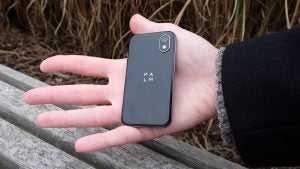
Still, the Palm Phone is meant for lighter tasks, and its 3GB of RAM meets that magic minimum target for fluid Android operation. I wouldn’t call the basic navigation experience stutter-free, but nor did I experience any lengthy lags. Jumping into the camera app from the lock-screen doesn’t take as long as you might expect, while the face-unlock system is surprisingly snappy and hopping between apps is sufficiently fluid.
Believe it or not, you can play games on the Palm Phone, potentially making this the diddiest gaming machine since Nintendo’s Game Boy Micro. And not just casual 2D time-wasters either. The likes of Asphalt 9 and Guns of Boom run surprisingly fluidly, once you’ve squinted your way through the menus.
This is great for novelty or show-off value, of course, but if you find yourself performing such advanced tasks on the Palm Phone on a regular basis, you’ll have missed the point spectacularly.
Palm Phone – Software
The Palm Phone runs on Android 8.1 Oreo, which isn’t the latest version of Google’s OS – but we’ve never encountered a phone where it matters so little.
Google’s OS is largely sequestered behind a highly streamlined UI that’s got more than a hint of the Apple Watch’s watchOS to it. The main homescreen is a vertically scrolling bundle of app icons, arranged in three higgledy-piggledy columns, over a black background. As you scroll down, fresh app icons at the bottom slowly come into focus, while the top ones fade out.
Swiping right will bring up Google Feed, while swiping left brings up a widget screen. This features a pretty useless Vodafone widget by default, but you can remove it and add the usual suite of Android widgets for your chosen apps.
The multi-functional capacitive button at the bottom of the device, below the screen, serves all three basic Android navigation bar functions. A single tap will back up to the previous screen or app, a sustained press will bring up the app-switching menu, while a double-tap will take you home.
Related: Best Android phones
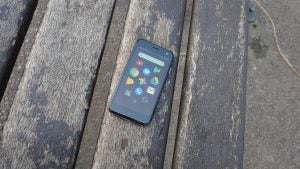
It’s a slightly fiddly and convoluted approach at first, but it’s something you’ll adapt to with time. Overall, the decision to trim away as much of the UI fat as possible seems like a smart one.
Actually gaining access to the homescreen is a simple case of hitting the power button and waiting for the face-unlock system to open the phone up. This takes a split second longer than we’d like, but it’s pretty reliable.
If you swipe up from the bottom of the lock-screen, you’ll bring up a blank area of the screen that lets you draw out a letter of the alphabet. Handwriting-recognition software will then bring up a list of contacts and apps that begin with that letter.
It works most of the time, but it’s not a feature you’re going to be using all the time. And you’ll need to be quick if you have face unlock enabled, as the phone will want to jump to the homescreen.
Life Mode is another headline software addition, although it doesn’t prove to be all that useful when you get down to it. Activate this from the notification menu, and all calls and messages will be blocked whenever the screen is off. In practice, there’s very little between this and simply hitting the Airplane Mode shortcut on your usual phone when you want a bit of quiet time.
While the Palm Phone can run pretty much any Android app out there, actually using those apps on the 3.3-inch display is an exercise in frustration and poor optimisation. Looking at pictures in Photos, watching videos in YouTube, and navigating maps in Google Maps is downright fiddly.
You might argue that trying to do all these things is rather missing the point, just as with playing high-end games. But all of those aforementioned Google apps are placed front and centre on the Palm’s simplified homescreen. You’re meant to use them, for however brief a period, and the experience simply isn’t up to scratch.
When it comes to downloading extra apps or media content, you’re stuck with the 32GB of onboard storage. There’s no microSD facility here.
It’s worth considering the practicality of running a second phone such as this. There are a lot of niggling barriers to entry, from the fact that the device is a timed Vodafone exclusive to the logistics of either swapping your existing Vodafone sim across or simply employing a second number.
If your primary phone is an iPhone then there’s another layer of awkwardness to overcome, especially when it comes to deactivating and reactivating the iMessage service.
The Palm Phone can be used on a shared number over in the US on Verizon, but that doesn’t seem to be an option on Vodafone here in the UK, removing a further layer of convenience. All in all, we have to question the Palm’s viability as a regular secondary device.
Palm Phone – Camera
Packing a 12-megapixel camera into such a small package sounds pretty impressive, and might fool you into imagining the Palm Phone as some sort of super-portable pocket camera.
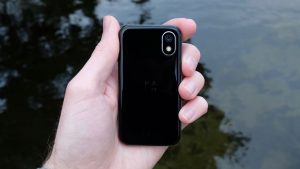
Actually using it should hopefully disabuse you of such a notion. It really isn’t a very good camera at all.
In ideal lighting, from the right angle, with minimal extremes of light and shade, you’ll be able to take some serviceable shots. But stray into lesser lighting conditions – even a well-lit lunch time service in a bright and airy cafe – and the results go out of the window.
The camera will swiftly start to struggle for brightness, detail, and focus in such conditions. Even in well-lit scenes, images can tend to look flat and overexposed. The latter is a shame, because there’s an auto-HDR mode activated by default, but it often fails to balance things out sufficiently.
There’s an 8-megapixel front-facing camera that will just about suffice for well-lit selfies in a pinch. Only in a pinch, mind.
It’s a real shame that the camera isn’t better, as you feel it’s the one area of traditional smartphone usage that shouldn’t have been compromised on. After all, in the consciously less cluttered, more social, heads-up life that this phone has been designed for, you have to suspect that people will want to take more photos, not fewer.

Even in evenly lit conditions, shots tend to look a little flat

Detail is pretty good on the lens in this close-up, although it gets a little too fuzzy too soon

Drop the light further, and you enter grain city

Regular shots tend to be flat and overexposed

A reasonably colour-accurate shot that nonetheless looks a little messy and indistinct


Palm Phone – Battery life
I’ve already mentioned that the cramped viewing experience on the Palm Phone’s 3.3-inch display represents quite a compromise. But it isn’t the worst component here by a long shot. At least that display is functional. You can load up and run any modern Android application on it, albeit in shrunken form.
The Palm Phone’s tiny 800mAh battery, on the other hand, feels borderline defective. It’s truly abysmal.
We noted several occasions during our test period where the Palm would drain with very little usage. On a leisurely two-hour walk around a park, during which I used the camera to take a dozen or so snaps, the phone lost 40% of its charge.
During a five-hour spell in which I downloaded an app on Wi-Fi, unlocked the phone to show it off to interested friends, and took a single snap with the camera, the Palm lost a significant 70% of its charge.
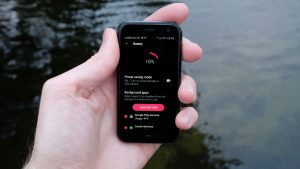
Just to reiterate, at no point during these two scenarios did I make or receive any calls, or do any messaging of any kind.
The Palm just isn’t a phone you can rely on for any protracted period of time, let alone a full day. And that seals its fate as a potential life-simplifying prospect in our book.
For the sake of comparison, I ran my usual personal test of playing 15 minutes of Guns of Boom with the screen brightness set to half. During this period, the Palm Phone lost 20% of its charge. The vast majority of phones I’ve tested from across the price and performance spectrum will sap between 5% and 7% in this test. While this isn’t what the Palm is meant for at all, the result still drives home how poor the battery performance is.
It simply doesn’t wash to say that this is a device that’s only meant for light or occasional usage either. The parallel has already been drawn to smartwatches in terms of their light, supplemental functionality. But even the most bog standard of wrist-mounted assistants will last you through a full day of usage.
Why buy the Palm Phone?
It feels a little strange criticising the Palm Phone, partly because there’s no precedent for a handset of this type, and partly because there’s undoubted appeal to its dinky design.
Pulling the Palm Phone out among a group of friends – both techy and non-techy – elicits considerable interest and unanimous praise. It’s an eye-catching, appealing device that makes a certain amount of sense at a time when plenty of people are growing tired of these oversized distraction machines we carry around in our pockets.
But I can’t in all conscience recommend the Palm Phone to anybody. It’s barely functional as a modern smartphone, even for the light usage for which it’s built.
Its tiny display – while plenty sharp enough – makes typing almost impossible, and renders any visual task an eye-straining mess. Meanwhile, the Palm’s battery life is woefully inadequate, making anything but a brief trip away from a wall socket seriously inadvisable. The camera isn’t up to much either.
Verdict
The Palm Phone is a noble failure. It’s a device that bravely explores a new path to recovering some of the lost time and attention that successive smartphones have stolen from us. Ultimately, though, it ends up stranded in a no-man’s land of tiny text and insufficient stamina.
How we test phones
We test every mobile phone we review thoroughly. We use industry standard tests to compare features properly and we use the phone as our main device over the review period. We’ll always tell you what we find and we never, ever, accept money to review a product.
Trusted Score
Score in detail
-
Performance 7
-
Camera 5
-
Design 8
-
Battery Life 2
-
Value 3
-
Calls & Sound 6
-
Screen Quality 6


